The Skylake Core i3 (51W) CPU Review: i3-6320, i3-6300 and i3-6100 Tested
by Ian Cutress on August 8, 2016 9:00 AM ESTGrand Theft Auto V
The highly anticipated iteration of the Grand Theft Auto franchise finally hit the shelves on April 14th 2015, with both AMD and NVIDIA in tow to help optimize the title. GTA doesn’t provide graphical presets, but opens up the options to users and extends the boundaries by pushing even the hardest systems to the limit using Rockstar’s Advanced Game Engine. Whether the user is flying high in the mountains with long draw distances or dealing with assorted trash in the city, when cranked up to maximum it creates stunning visuals but hard work for both the CPU and the GPU.
For our test we have scripted a version of the in-game benchmark, relying only on the final part which combines a flight scene along with an in-city drive-by followed by a tanker explosion. We record both the average frame rate and the percentage of frames under 60 FPS (16.6ms).
For this test we used the following settings with our graphics cards:
| Grand Theft Auto Settings | |||
| Resolution | Quality | ||
| Low GPU | Integrated Graphics | 1280x720 | Lowest |
| ASUS R7 240 1GB DDR3 | |||
| Medium GPU | MSI GTX 770 Lightning 2GB | 1920x1080 | Very High |
| MSI R9 285 Gaming 2G | |||
| High GPU | ASUS GTX 980 Strix 4GB | 1920x1080 | Very High |
| MSI R9 290X Gaming 4G | |||
Integrated Graphics
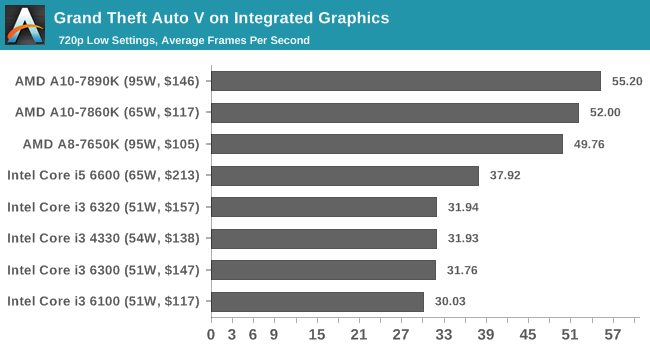
![Grand Theft Auto V on Integrated Graphics [Under 60 FPS]](https://images.anandtech.com/graphs/graph10543/83071.png)
The APUs take a large, almost double FPS lead for average frame rates, and again the Core i3 staircase shows that the L3 cache makes a difference. On the Low FPS graph, we see that none of the Intel CPUs make it above 60 FPS at any point, whereas the APUs can expect to see 15-30% of their time at or above 60 FPS.
Discrete Graphics
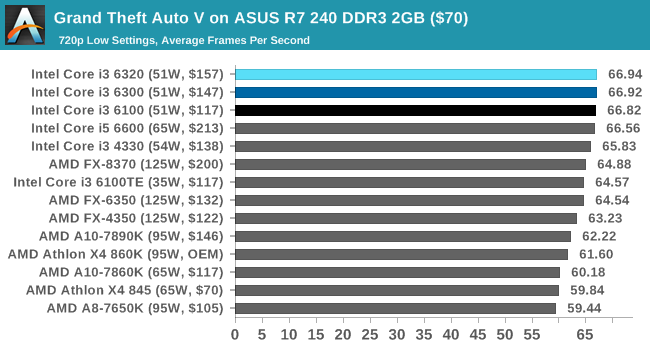
![Grand Theft Auto V on ASUS R7 240 DDR3 2GB ($70) [Under 60 FPS]](https://images.anandtech.com/graphs/graph10543/83079.png)
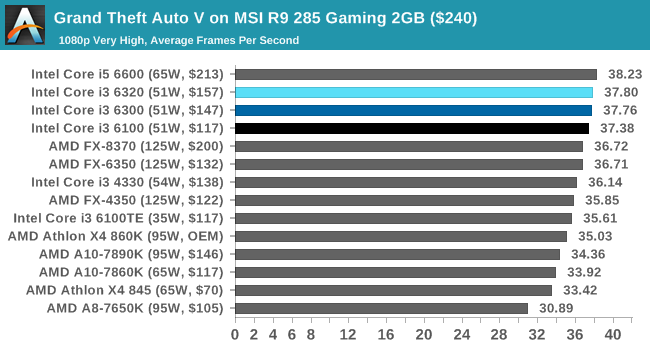
![Grand Theft Auto V on MSI R9 285 Gaming 2GB ($240) [Under 60 FPS]](https://images.anandtech.com/graphs/graph10543/83087.png)
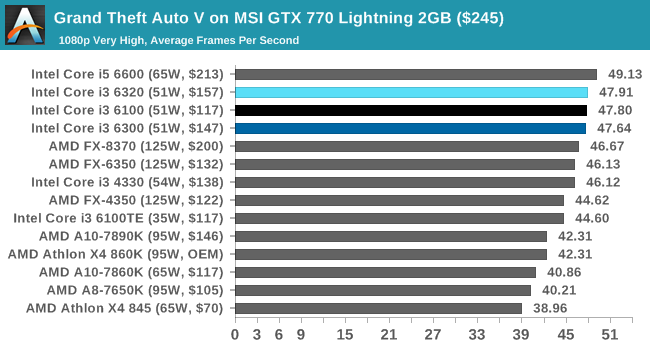
![Grand Theft Auto V on MSI GTX 770 Lightning 2GB ($245) [Under 60 FPS]](https://images.anandtech.com/graphs/graph10543/83095.png)
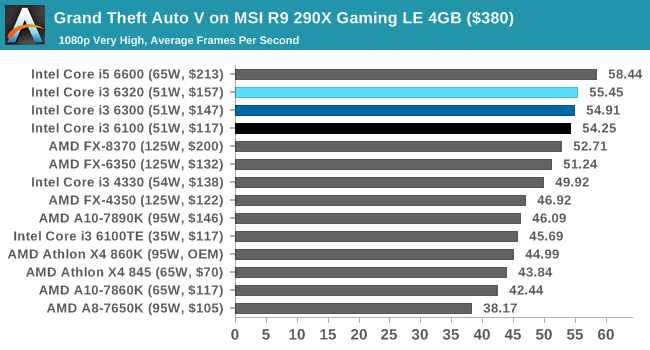
![Grand Theft Auto V on MSI R9 290X Gaming LE 4GB ($380) [Under 60 FPS]](https://images.anandtech.com/graphs/graph10543/83103.png)
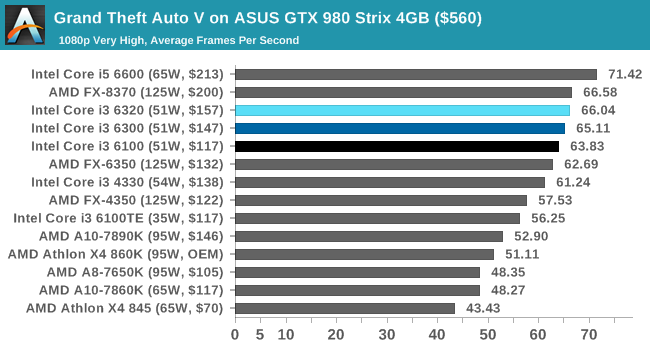
![Grand Theft Auto V on ASUS GTX 980 Strix 4GB ($560) [Under 60 FPS]](https://images.anandtech.com/graphs/graph10543/83113.png)
It's an onslaught of data, but clicking through to each graph will expand it in finer detail.
Again, with a discrete GPU, the Core i3s sit very pretty at the top of our graphs. In most cases, against similarly priced AMD CPUs, they can be from 5% to 20% quicker in average frame rates - the higher power the GPU, the more that it matters.
An interesting graph is the final one, with the GTX 980 and lookng at the percentage of frames over 16.6ms (i.e., the percentage time the game spends under 60 FPS). With the Core i3 parts, the game spends at least 50% of its time above 60 FPS running at 1080p Very High settings, however with similarly priced AMD APUs, this drops down to 15-25%. While running at V-Sync, this will be noticable. The FX CPUs get a better showing with the GTX 980, with the FX-6350 and the FX-8350 straddling the Core i3s for average frame rates and the 60 FPS metric.











94 Comments
View All Comments
Andr3w - Friday, September 16, 2016 - link
Hello guys ! I currently own a 860k OC at 4.2 Ghz paired with a Sapphire R7 370 2gb . After consulting this review I understand that the i3-6100 paired with the same R7 370 will perform better in gaming ? Correct me if I am wrong !Note : Currently I think, the 860k bottlenecks my R7 370 in Tom Clancy The Division. I am sayng this becasue the readings from MSI Afterburner show the following stats at medium settings, 1920x1080 resolution, V-Sync off :
GPU Usage 65 - 70 % with 1800 VRAM usage
CPU Usage on all 4 cores : 98 - 100 %
On the other hand in Star Wars Battlefront, on high settings, 1920x1080 resolution, V-Sync off, I've read the following stats :
GPU Usage : 100 % with about 1700 VRAM usage
CPU Usage : 65-70 % on all 4 cores.
So will it worth changing to i3-6100 ?
KosOR - Tuesday, October 30, 2018 - link
Recently, I had an opportunity to purchase cheaper new Haswell or Skylake motherboard together with cheaper second hand i3 processor. And I searched and found this article comparing i3-6100 and i3-4330 processors. I also compared both CPUs at PassMark and UserBenchmark results (cpubenchmark.net, userbenchmark.com). The cumulative performance difference there was not greater than 15%. The 15% number seems also compatible with CPU architecture improvement and slightly higher clock speeds. That's why I was very surprised to see much higher performance difference in this article for almost all real world tests (Dolphin Benchmark, 3D Particle Movement v2, Mozilla Kraken and Google Octane v2). Personally, I could not find any logical reasons explaining those elevated performance numbers of Skylake i3 CPUs. Can anybody explain me why we see such big (greater than 30%) real world performance differences in all of those tests?KosOR - Tuesday, October 30, 2018 - link
Those higher than 15% performance numbers are also observable in 2 other test results - HandBrake v0.9.9 2x4K and Hybrid x265. Can anybody find the explanation in any of the architecture improvements from Haswell to Skylake generation of CPUs?KosOR - Tuesday, October 30, 2018 - link
Yet another absurd result is of Pentium G3420, which wins over i3 4330 on Dolphin benchmark by more than 15%. It looks absurd that 2 thread, 3.2GHz, 3 MB cache Haswell processor achieves 15% better result over 4 thread, 3.5GHz, 4 MB cache Haswell processor. Such results make me feel suspicious of all other test results on the charts, sorry.